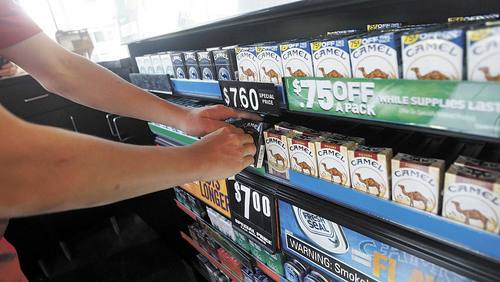The young and poor are keeping big American tobacco alive
By Roberto A. Ferdman, The Washington Post
Big American tobacco wants to get bigger in America.
Reynolds American Inc., which sells both Camel and Pall Mall cigarettes, has agreed to acquire rival and Newport menthol-maker Lorillard for an estimated $27.4 billion. If approved, the deal will effectively combine the portfolios of two of the country’s largest cigarette companies—as of last year, Reynolds and Lorillard controlled roughly 26 percent and 14 percent of the U.S. market, respectively—and send a number of brands to the smaller but still significant player Imperial Tobacco Group.
“The deal strengthens Reynolds position in the US, supplying them with Newport’s excellent brand equity and establishes Imperial as a viable third force in the world’s third largest cigarette market by volume,” Shane MacGuill, Tobacco analyst at Euromonitor International, said in an interview.
The shuffle atop American tobacco is a sign that consolidation might be the industry’s best way to cope with the country’s growing disinterest in cigarettes. It also nods to a few areas of potential growth, most notably menthol cigarettes, for which sales have proven comparatively resilient—Newports, a menthol brand, is second only to Marlboro in U.S. sales.
But the deal is also a surprising indication of optimism surrounding the U.S. industry.
“The U.S. is a key growth market for us,” Alison Cooper, Chief Executive for Imperial Tobacco Group, said in a call with reporters. “We’re hugely excited about the opportunities that lie ahead.”
Why? Because the American tobacco market, while challenged, is still more attractive than many of its international counterparts. The U.S. tobacco market contracted by four percent last year, according to the Food and Drug Administration, but cigarette sales in Europe are falling even faster—they are now nearly half what they were in 2000—and other markets are difficult to penetrate. China’s, while growing, is dominated by local player China National Tobacco Corp.
Make no mistake, cigarette consumption has long been in decline in the United States. Americans adults, on average, smoke fewer than 1,300 cigarettes per year, according to a report (pdf) released earlier this year by the Surgeon General. By comparison, that number was upwards of 4,200 in 1963–three times the current figure.
But some states and demographics still seem to be clinging on to the habit–and keeping American tobacco companies afloat.
“Approximately one in five U.S. adults smoke cigarettes, and certain population groups have a higher prevalence of smoking,” the Centers for Disease Control and Prevention (CDC) noted in a report from earlier this year.
On a state-by-state level, that certainly appears to be true. Take Kentucky and West Virginia, for instance, which each sport smoking rates well above the national average, according to the CDC’s report. More than 28 percent of Kentucky’s and West Virginia’s adult population were regular or frequent smokers as of 2012. In Utah, smokers made up barely more than 10 percent of the population; in California, just over 12 percent; and in New York, just over 16 percent. The national smoking rate was just above 18 percent.
Smoking, as it happens, also appears to be highly correlated with both poverty and education levels in the United States: 27.9 percent of American adults living below the poverty line are smokers, while just 17 percent of those living above it are, according to the CDC; 24.7 percent of American adults without a high school diploma are smokers, while 23.1 percent of those with one are. Only 9.1 percent of those with an undergraduate degree, and 5.9 percent of those with a graduate degree are smokers.
It ranges considerably by race, too. The CDC found that Americans of mixed race were the biggest smokers, with 26.1 percent still smoking cigarettes in 2012. Next were Native Americans, with 21.8 percent smoking. By comparison, only 10.7 of Asians smoked in 2012, according to the survey.
And cigarettes are most popular among those adults between the ages of 25 and 44 years old: 21.6 percent of the age group smokes, more than any other.

If the big tobacco deal is approved, Reynolds will suddenly find itself with more than 30 percent of the American market, and Imperial will find itself with more than 10 percent (Altria Group, which owns Marlboro, controls nearly 50 percent). Don’t be surprised if both turn to those Americans who have been slowest at kicking their respective cigarette habits for help.
http://www.washingtonpost.com/blogs/wonkblog/wp/2014/07/16/the-young-and-poor-are-keeping-the-u-s-tobacco-industry-alive/






